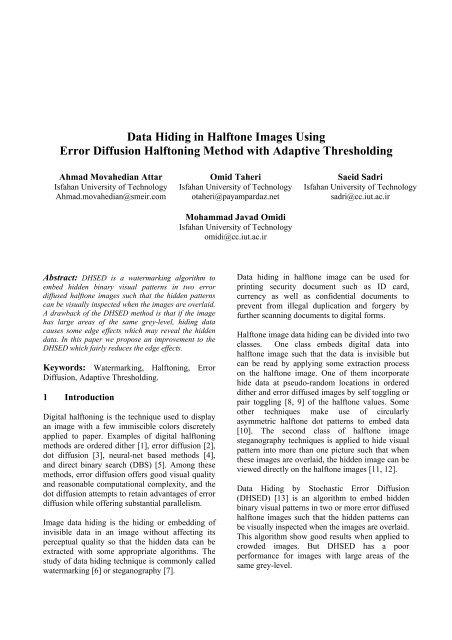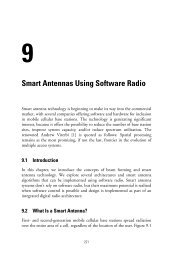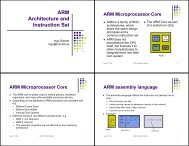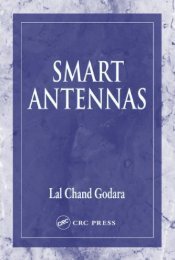Data Hiding in Halftone Images Using Error ... - M. Javad Omidi
Data Hiding in Halftone Images Using Error ... - M. Javad Omidi
Data Hiding in Halftone Images Using Error ... - M. Javad Omidi
Create successful ePaper yourself
Turn your PDF publications into a flip-book with our unique Google optimized e-Paper software.
<strong>Data</strong> <strong>Hid<strong>in</strong>g</strong> <strong>in</strong> <strong>Halftone</strong> <strong>Images</strong> Us<strong>in</strong>g<br />
<strong>Error</strong> Diffusion Halfton<strong>in</strong>g Method with Adaptive Threshold<strong>in</strong>g<br />
Ahmad Movahedian Attar<br />
Isfahan University of Technology<br />
Ahmad.movahedian@smeir.com<br />
Omid Taheri<br />
Isfahan University of Technology<br />
otaheri@payampardaz.net<br />
Mohammad <strong>Javad</strong> <strong>Omidi</strong><br />
Isfahan University of Technology<br />
omidi@cc.iut.ac.ir<br />
Saeid Sadri<br />
Isfahan University of Technology<br />
sadri@cc.iut.ac.ir<br />
Abstract: DHSED is a watermark<strong>in</strong>g algorithm to<br />
embed hidden b<strong>in</strong>ary visual patterns <strong>in</strong> two error<br />
diffused halftone images such that the hidden patterns<br />
can be visually <strong>in</strong>spected when the images are overlaid.<br />
A drawback of the DHSED method is that if the image<br />
has large areas of the same grey-level, hid<strong>in</strong>g data<br />
causes some edge effects which may reveal the hidden<br />
data. In this paper we propose an improvement to the<br />
DHSED which fairly reduces the edge effects.<br />
Keywords: Watermark<strong>in</strong>g, Halfton<strong>in</strong>g, <strong>Error</strong><br />
Diffusion, Adaptive Threshold<strong>in</strong>g.<br />
1 Introduction<br />
Digital halfton<strong>in</strong>g is the technique used to display<br />
an image with a few immiscible colors discretely<br />
applied to paper. Examples of digital halfton<strong>in</strong>g<br />
methods are ordered dither [1], error diffusion [2],<br />
dot diffusion [3], neural-net based methods [4],<br />
and direct b<strong>in</strong>ary search (DBS) [5]. Among these<br />
methods, error diffusion offers good visual quality<br />
and reasonable computational complexity, and the<br />
dot diffusion attempts to reta<strong>in</strong> advantages of error<br />
diffusion while offer<strong>in</strong>g substantial parallelism.<br />
Image data hid<strong>in</strong>g is the hid<strong>in</strong>g or embedd<strong>in</strong>g of<br />
<strong>in</strong>visible data <strong>in</strong> an image without affect<strong>in</strong>g its<br />
perceptual quality so that the hidden data can be<br />
extracted with some appropriate algorithms. The<br />
study of data hid<strong>in</strong>g technique is commonly called<br />
watermark<strong>in</strong>g [6] or steganography [7].<br />
<strong>Data</strong> hid<strong>in</strong>g <strong>in</strong> halftone image can be used for<br />
pr<strong>in</strong>t<strong>in</strong>g security document such as ID card,<br />
currency as well as confidential documents to<br />
prevent from illegal duplication and forgery by<br />
further scann<strong>in</strong>g documents to digital forms.<br />
<strong>Halftone</strong> image data hid<strong>in</strong>g can be divided <strong>in</strong>to two<br />
classes. One class embeds digital data <strong>in</strong>to<br />
halftone image such that the data is <strong>in</strong>visible but<br />
can be read by apply<strong>in</strong>g some extraction process<br />
on the halftone image. One of them <strong>in</strong>corporate<br />
hide data at pseudo-random locations <strong>in</strong> ordered<br />
dither and error diffused images by self toggl<strong>in</strong>g or<br />
pair toggl<strong>in</strong>g [8, 9] of the halftone values. Some<br />
other techniques make use of circularly<br />
asymmetric halftone dot patterns to embed data<br />
[10]. The second class of halftone image<br />
steganography techniques is applied to hide visual<br />
pattern <strong>in</strong>to more than one picture such that when<br />
these images are overlaid, the hidden image can be<br />
viewed directly on the halftone images [11, 12].<br />
<strong>Data</strong> <strong>Hid<strong>in</strong>g</strong> by Stochastic <strong>Error</strong> Diffusion<br />
(DHSED) [13] is an algorithm to embed hidden<br />
b<strong>in</strong>ary visual patterns <strong>in</strong> two or more error diffused<br />
halftone images such that the hidden patterns can<br />
be visually <strong>in</strong>spected when the images are overlaid.<br />
This algorithm show good results when applied to<br />
crowded images. But DHSED has a poor<br />
performance for images with large areas of the<br />
same grey-level.
In this paper we propose a modification to DHSED<br />
which show better results for both crowded and<br />
uniform images. Section 2 devotes to <strong>in</strong>troduction<br />
of <strong>Error</strong> diffusion halfton<strong>in</strong>g and DHSED<br />
algorithms. In section 3 we present the Adaptive<br />
Threshold<strong>in</strong>g method to improve the performance<br />
of DHSED for images with large areas of the same<br />
grey-level. Section 4 conta<strong>in</strong>s some simulation<br />
results and section 5 concludes the paper.<br />
2 <strong>Error</strong> Diffusion and DHSED<br />
algorithms<br />
In this section we first <strong>in</strong>troduce the <strong>Error</strong><br />
Diffusion halfton<strong>in</strong>g algorithm, and then DHSED<br />
algorithm is completely described. We then show<br />
poor performance of DHSED algorithm over<br />
images with large areas of the same grey-level.<br />
2.1 <strong>Error</strong> Diffusion Halfton<strong>in</strong>g Algorithm<br />
As stated <strong>in</strong> the <strong>in</strong>troduction, there are several<br />
image halfton<strong>in</strong>g techniques. Among these<br />
methods <strong>Error</strong> Diffusion and Dot Diffusion show<br />
pretty good performance. In <strong>Error</strong> Diffusion<br />
halfton<strong>in</strong>g, the quantization error at each pixel is<br />
filtered and fed back to the <strong>in</strong>put <strong>in</strong> order to diffuse<br />
the error among neighbour<strong>in</strong>g greyscale pixels. In<br />
this paper the Floyd-Ste<strong>in</strong>berg kernel is used to<br />
diffuse the error to neighbour<strong>in</strong>g pixels. The<br />
Floyd-Ste<strong>in</strong>berg error diffusion filter is shown <strong>in</strong><br />
figure 1, <strong>in</strong> which X denotes the current pixel.<br />
0 0 0<br />
0 X 7/16<br />
3/16 5/16 1/16<br />
Figure 1: Floyd-Ste<strong>in</strong>berg error diffusion filter<br />
Let the <strong>in</strong>put multi-tone image be X, with pixel<br />
values x(i,j) and let Y be the output halftoned<br />
image. The algorithm can be described <strong>in</strong> the<br />
follow<strong>in</strong>g steps:<br />
1- Compute the feed-forward error a ( i,<br />
j)<br />
.<br />
1<br />
1<br />
a ( i,<br />
j)<br />
= ∑e(<br />
i − k,<br />
j − l)ker(<br />
k,<br />
l)<br />
(1)<br />
16<br />
k , l =−1<br />
Where e(i,j) is the halfton<strong>in</strong>g error and ker(k,l)<br />
denotes the Floyd-Ste<strong>in</strong>berg filter coefficients as<br />
shown <strong>in</strong> figure 1.<br />
2- Update the pixel value x ( i,<br />
j)<br />
f ( i,<br />
j)<br />
= x(<br />
i,<br />
j)<br />
+ a(<br />
i,<br />
j)<br />
(2)<br />
3- Compare the updated multi-tone pixel value<br />
f ( i,<br />
j)<br />
with a threshold T (T=128) and specify the<br />
output halftoned pixel y ( i,<br />
j)<br />
.<br />
⎧0<br />
f ( i,<br />
j)<br />
< T<br />
y( i,<br />
j)<br />
= ⎨<br />
(3)<br />
⎩255<br />
f ( i,<br />
j)<br />
≥ T<br />
4- Compute the halfton<strong>in</strong>g error.<br />
e( i,<br />
j)<br />
= f ( i,<br />
j)<br />
− y(<br />
i,<br />
j)<br />
(4)<br />
2.2 <strong>Data</strong> <strong>Hid<strong>in</strong>g</strong> by Stochastic <strong>Error</strong><br />
Diffusion (DHSED) Algorithm<br />
Suppose that we want to hide the b<strong>in</strong>ary image H<br />
<strong>in</strong> a halftone image based on X. Instead of hid<strong>in</strong>g<br />
data <strong>in</strong> just one halftone image, DHSED is an<br />
algorithm to hide <strong>in</strong>visible watermark<strong>in</strong>g data or<br />
patterns <strong>in</strong> a halftone image Y 1<br />
and simultaneously<br />
relevant to it another halftone image Y 0<br />
is made so<br />
that the hidden data can be detected when Y 0<br />
and<br />
Y are overlaid.<br />
1<br />
In the follow<strong>in</strong>g discussion all the matrices are<br />
supposed to be M×N. We will use x ( i,<br />
j)<br />
and y k<br />
( i,<br />
j)<br />
, k=0, 1, to represent the pixels at<br />
location ( i , j)<br />
of X and Y respectively.<br />
k<br />
The first image Y is generated by apply<strong>in</strong>g Floyd-<br />
0<br />
Ste<strong>in</strong>berg error diffusion method to the image X.<br />
Let H and<br />
W<br />
H be the collection of white and<br />
B<br />
black pixels <strong>in</strong> H respectively. DHSED applies a<br />
morphological dilation to H with a structur<strong>in</strong>g<br />
B<br />
element S. Let D be the dilated version of H . We<br />
B<br />
can partition the pixels of image X <strong>in</strong>to three<br />
groups as follows:<br />
1- The pixels belong<strong>in</strong>g to H (:<br />
B<br />
P 1<br />
).<br />
2- The pixels belong to D ∩ H (:<br />
W<br />
P ). (Note that<br />
2<br />
P<br />
2<br />
corresponds to the narrow strip added around<br />
H to construct D).<br />
B<br />
3- The pixels not belong<strong>in</strong>g to D (: P ).<br />
3<br />
To generate Y 1<br />
with respect to the hidden data H,<br />
DHSED beg<strong>in</strong> to halftone X by <strong>Error</strong> Diffusion<br />
algorithm but modifies the algorithm for pixel<br />
groups belong<strong>in</strong>g to one of the sets P 1<br />
, P and<br />
2 P 3<br />
respectively. If the pixel ( i , j)<br />
belongs to P 1<br />
the<br />
traditional <strong>Error</strong> Diffusion method is applied. If the<br />
pixel ( i , j)<br />
belongs to P 2<br />
, equations 1 and 2 are<br />
used to compute a ( i,<br />
) and f ( i,<br />
) . Instead of<br />
1<br />
j<br />
1<br />
j
equation 3 we use y<br />
1( i,<br />
j)<br />
= y0(<br />
i,<br />
j)<br />
and <strong>in</strong>stead of<br />
equation 4 we apply the follow<strong>in</strong>g equation:<br />
e i,<br />
j)<br />
= max(m<strong>in</strong>( f ( i,<br />
j)<br />
− y ( i,<br />
j),<br />
127), 127) (5)<br />
1( 1 1<br />
−<br />
F<strong>in</strong>ally, if the pixel ( i , j)<br />
belongs to P ,<br />
3<br />
y<br />
1( i,<br />
j)<br />
= y0(<br />
i,<br />
j)<br />
and e<br />
1<br />
( i,<br />
j)<br />
= 0 .<br />
To make the above discussion clearer we present<br />
an example of DHSED. Figure 2 shows the picture<br />
H which is to be hided.<br />
Figure 5: The image Y (With hidden data)<br />
1<br />
Figure 2: The hidden picture H<br />
Figure 3 shows the orig<strong>in</strong>al greyscale image X.<br />
figures 4 and 5 are Y 0<br />
and Y<br />
1<br />
respectively and<br />
figure 6 shows the overlaid image.<br />
Figure 6: Result of overlay<strong>in</strong>g Y and<br />
0<br />
Y<br />
1<br />
To show the short com<strong>in</strong>g of the above algorithm<br />
we make use of an image X which is divided <strong>in</strong>to<br />
two parts with different brightness. The hidden text<br />
is a 'T' character. Figure 7 is the output halftoned<br />
image<br />
Y<br />
1 . Note that the edges of the hidden text<br />
character are detectable <strong>in</strong> figure 7, and perhaps by<br />
some process<strong>in</strong>g it can be extracted. In the<br />
follow<strong>in</strong>g section we propose an Adaptive<br />
Threshold<strong>in</strong>g method to reduce this effect.<br />
Figure 3: The orig<strong>in</strong>al greyscale image X<br />
Figure 4: The image Y (With no hidden data)<br />
0<br />
Figure 7: The edge effect <strong>in</strong><br />
1<br />
Y for a hidden 'T'<br />
character
3 DHSED with Adaptive Threshold<strong>in</strong>g<br />
In this section we propose a method to reduce the<br />
above mentioned drawback of DHSED. These<br />
edge effects occur for the pixels <strong>in</strong> set P<br />
1<br />
, because<br />
the pixels <strong>in</strong> P<br />
2<br />
and P 3<br />
<strong>in</strong> image Y 1<br />
have the same<br />
grey-level as imageY 0<br />
but the error e<br />
1(<br />
i,<br />
j)<br />
of these<br />
pixels <strong>in</strong> Y is different from<br />
1<br />
( i,<br />
) Y .<br />
e<br />
0<br />
j <strong>in</strong> 0<br />
Although this is the key po<strong>in</strong>t <strong>in</strong> DHSED, by<br />
which the data can be extracted by overlay<strong>in</strong>g<br />
images, at the same time it leads to some visually<br />
detectable changes <strong>in</strong> imageY 1<br />
.<br />
If image Y 1<br />
<strong>in</strong> figure 7 is <strong>in</strong>vestigated, we see that<br />
the boundary of character 'T' <strong>in</strong> the upper part of<br />
the halftoned image is darker than the background<br />
and the boundary <strong>in</strong> the lower part is brighter than<br />
the background. Now to br<strong>in</strong>g the brightness of the<br />
boundaries to the natural brightness of each part,<br />
we choose the threshold to halftone the boundaries<br />
adapted to the brightness of that part. For the upper<br />
dark part of the image the threshold is chosen<br />
lower than 128, while for the brighter lower part<br />
the threshold is chosen higher than 128.<br />
So we need a measure of the average grey-level at<br />
every pixel of image X to adjust the halfton<strong>in</strong>g<br />
threshold T. This measure may simply be the pixel<br />
values of the low-pass filtered version of the<br />
orig<strong>in</strong>al image X. Suppose that Z is the low-pass<br />
filtered version of X, by the ( 2L<br />
+ 1) × (2L<br />
+ 1)<br />
averag<strong>in</strong>g filter. If we choose a and b as lower and<br />
upper thresholds respectively, the adaptive<br />
threshold T is calculated us<strong>in</strong>g the follow<strong>in</strong>g<br />
a<br />
equation.<br />
⎧a<br />
z(<br />
i,<br />
j)<br />
< l<br />
⎪<br />
T a<br />
= ⎨b<br />
z(<br />
i,<br />
j)<br />
≥ u<br />
(6)<br />
⎪<br />
⎩128<br />
otherwise<br />
edge effects <strong>in</strong> figure 7 are reduced when us<strong>in</strong>g<br />
Adaptive Thresholded DHSED <strong>in</strong>stead of the<br />
simple DHSED. However <strong>in</strong> real pictures there<br />
aren’t such large areas of the same grey-level as<br />
shown <strong>in</strong> figures 7 and 8, therefore us<strong>in</strong>g Adaptive<br />
Thresholded DHSED can blur the visual edges of<br />
the hidden text <strong>in</strong> areas of the same grey-level.<br />
Figure 8: Image Y<br />
1<br />
us<strong>in</strong>g Adaptive Thresholded<br />
DHSED<br />
4 Simulation Results<br />
The proposed Adaptive Thresholded DHSED is<br />
simulated us<strong>in</strong>g the 256 × 256 Peppers image <strong>in</strong><br />
figure 3. The error diffused halftone image us<strong>in</strong>g<br />
Floyd-Ste<strong>in</strong>berg kernel with no hidden dataY 0<br />
, is<br />
shown <strong>in</strong> figure 4. The error diffused halftone<br />
image us<strong>in</strong>g Adaptive Thresholded DHSED with<br />
figure 2 as the watermark image is shown <strong>in</strong> figure<br />
9. Note the visual edges of the first 'E' character of<br />
the hidden text <strong>in</strong> figure 5, which has been<br />
improved us<strong>in</strong>g the Adaptive Threshold<strong>in</strong>g scheme<br />
as shown <strong>in</strong> figure 9. Figure 10 shows the overlaid<br />
version of Y 0<br />
and the watermarked image <strong>in</strong> figure<br />
9. The hidden pattern can be visualized also by a<br />
simple XNOR boolean operation. The result of<br />
XNOR<strong>in</strong>g Y and<br />
0<br />
Y<br />
1<br />
is shown <strong>in</strong> figure 11.<br />
In (6) l128, l is a criterion of be<strong>in</strong>g<br />
dark while u is a criterion of be<strong>in</strong>g bright. It is<br />
clear that <strong>in</strong> dark areas = a < 128 , while <strong>in</strong><br />
bright areas = b > 128 . In the results shown <strong>in</strong><br />
T a<br />
this paper we have chosen the follow<strong>in</strong>g values for<br />
a, b, u and l.<br />
a = 70 b = 155 u = 130 l = 90 (7)<br />
T a<br />
Figure 8 shows the result of apply<strong>in</strong>g DHSED with<br />
the adaptive threshold T a<br />
<strong>in</strong> (6) to the synthetic<br />
image used <strong>in</strong> the previous section. Note that the<br />
Figure 9: Watermarked image us<strong>in</strong>g Adaptive<br />
Thresholded DHSED
Figure 10: Result of overlay<strong>in</strong>g Y and the image <strong>in</strong><br />
0<br />
figure 9<br />
Figure 11: Visualiz<strong>in</strong>g the hidden pattern by the XNOR<br />
boolean operation<br />
5 Conclusion<br />
DHSED can embed hidden pattern <strong>in</strong> two visually<br />
halftone images. The pattern is visible through<br />
overlay<strong>in</strong>g or XNOR boolean operation. This<br />
method shows edge effects when apply<strong>in</strong>g to<br />
synthetic images. In this paper we propose the<br />
Adaptive Threshold<strong>in</strong>g method to reduce the edge<br />
effects of DHSED. In the experiments, Adaptive<br />
Threshold<strong>in</strong>g found to be very effective <strong>in</strong><br />
reduc<strong>in</strong>g the edge effects of DHSED without<br />
affect<strong>in</strong>g the visual quality of the watermarked<br />
image.<br />
Acknowledgements<br />
We would like to thank Mr. Mojtaba Mahdavi<br />
because of his useful comments.<br />
[2] R. Floyd and L. Ste<strong>in</strong>berg, “An adaptive<br />
algorithm for spatial greyscale”. Journal of the<br />
Society for Information Display. pp. 36-37 ,<br />
1976.<br />
[3] M. Mese and P. P. Vaidyanathan, “Optimized<br />
Halfton<strong>in</strong>g Us<strong>in</strong>g Dot Diffusion and Methods<br />
for Inverse Halfton<strong>in</strong>g”. IEEE Trans. On<br />
image process<strong>in</strong>g. Vol. 9, No. 4, pp. 691-709,<br />
2000.<br />
[4] D. Anastassiou, “Neural net based digital<br />
halfton<strong>in</strong>g of images”. Proc. IEEE<br />
International Symposium on Circuits and<br />
Systems. Espoo, pp. 507-510, 1988.<br />
[5] M. A. Seldowitz, j. P. Allebach and D. E.<br />
Sweeney, “Synthesis of digital holograms by<br />
direct b<strong>in</strong>ary search”. Applied Optics. vol.26,<br />
pp. 2788-2798, 1987.<br />
[6] F. M<strong>in</strong>tzer, et al., “Effective and Ineffective<br />
Digital Watermarks”. Proc of IEEE <strong>in</strong>t. Conf.<br />
on image process<strong>in</strong>g. pp. 9-13, 1997.<br />
[7] N. F. Johnson, S. Jaodia “Explor<strong>in</strong>g<br />
Steganography : See<strong>in</strong>g the Unseen”. IEEE<br />
Computer. vol.31, No.2, pp. 26-34, 1998.<br />
[8] M. S. Fu, O. C. Au, “<strong>Data</strong> <strong>Hid<strong>in</strong>g</strong> <strong>in</strong> <strong>Halftone</strong><br />
Image by Pixel Toggl<strong>in</strong>g”. Proc. of SPIE Int.<br />
Conf on Security and Watermark<strong>in</strong>g of<br />
Multimedia Contents. Vol. 3971, pp. 228-236,<br />
2000.<br />
[9] M. S. Fu, O. C. Au, “<strong>Data</strong> hid<strong>in</strong>g by smart pair<br />
toggl<strong>in</strong>g for halftone images”. Proc. Of IEEE<br />
Int. Conf. on Acoustics, Speech, and Signal<br />
Process<strong>in</strong>g. Istanbul, pp. 2318 -2321, 2000.<br />
[10] R. T. Tow, “Methods and Means for<br />
Embedd<strong>in</strong>g Mach<strong>in</strong>e Readable Digital <strong>Data</strong> <strong>in</strong><br />
<strong>Halftone</strong> <strong>Images</strong>”. United States Patent No.<br />
5315098.<br />
[11] K.T. box, “Digital Watermark<strong>in</strong>g Us<strong>in</strong>g<br />
Stochastic Screen Patterns”. United States<br />
Patent No. 5734752.<br />
[12] S. G. Wang, “Digital Watermarlung Us<strong>in</strong>g<br />
Conjugate <strong>Halftone</strong> Screens”. United States<br />
Patent No. 5790703.<br />
[13] M. S. Fu, O. C. Au, “<strong>Data</strong> hid<strong>in</strong>g <strong>in</strong> halftone<br />
images by stochastic error diffusion”. Proc.<br />
Int. Conf. on Acoustics, Speech, and Signal<br />
Process<strong>in</strong>g. Salt Lake City, pp. 1965 – 1968,<br />
2001.<br />
References<br />
[1] B. E. Bayer, “An optimum method for two<br />
level rendition of cont<strong>in</strong>uous tone pictures”.<br />
Proc. Int. Conf. on Communications. New<br />
York, pp. 26-11 - 26-15, 1973.



![[2]Cognitive radio architecture : the engineering ... - M. Javad Omidi](https://img.yumpu.com/50587986/1/163x260/2cognitive-radio-architecture-the-engineering-m-javad-omidi.jpg?quality=85)




